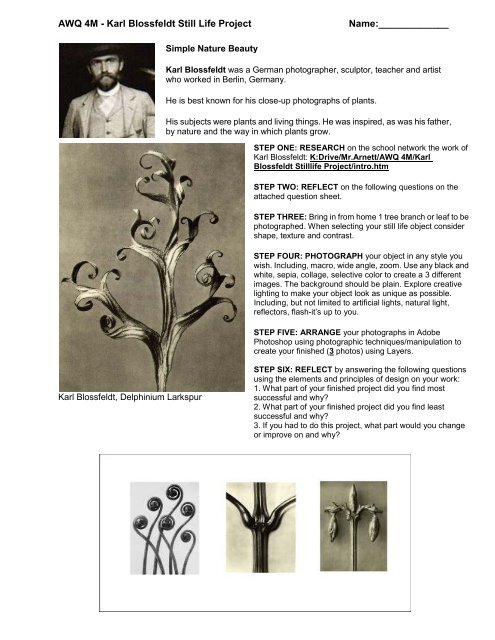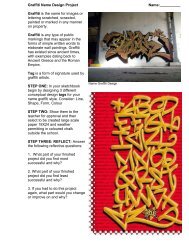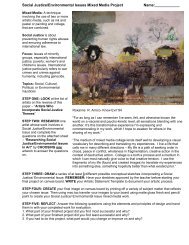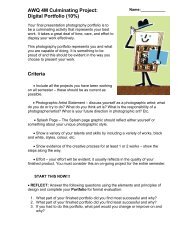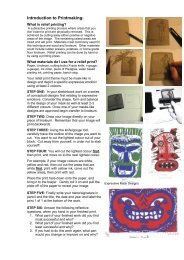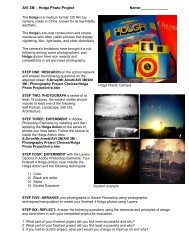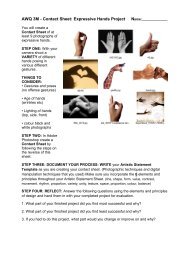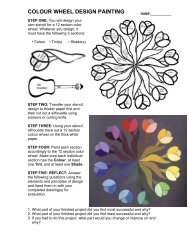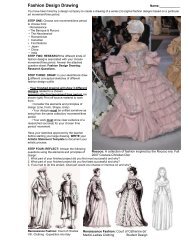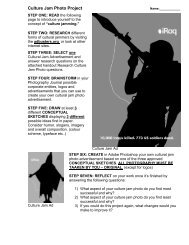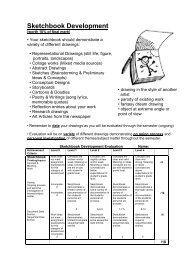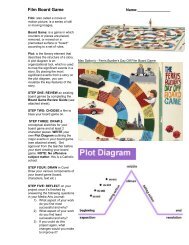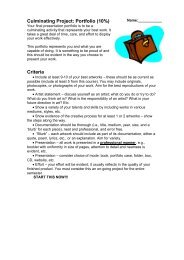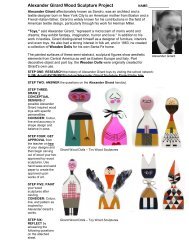Karl Blossfeldt Stilllife Project
Karl Blossfeldt Stilllife Project
Karl Blossfeldt Stilllife Project
You also want an ePaper? Increase the reach of your titles
YUMPU automatically turns print PDFs into web optimized ePapers that Google loves.
AWQ 4M - <strong>Karl</strong> <strong>Blossfeldt</strong> Still Life <strong>Project</strong><br />
Name:_____________<br />
Simple Nature Beauty<br />
<strong>Karl</strong> <strong>Blossfeldt</strong> was a German photographer, sculptor, teacher and artist<br />
who worked in Berlin, Germany.<br />
He is best known for his close-up photographs of plants.<br />
His subjects were plants and living things. He was inspired, as was his father,<br />
by nature and the way in which plants grow.<br />
STEP ONE: RESEARCH on the school network the work of<br />
<strong>Karl</strong> <strong>Blossfeldt</strong>: K:Drive/Mr.Arnett/AWQ 4M/<strong>Karl</strong><br />
<strong>Blossfeldt</strong> <strong>Stilllife</strong> <strong>Project</strong>/intro.htm<br />
STEP TWO: REFLECT on the following questions on the<br />
attached question sheet.<br />
STEP THREE: Bring in from home 1 tree branch or leaf to be<br />
photographed. When selecting your still life object consider<br />
shape, texture and contrast.<br />
STEP FOUR: PHOTOGRAPH your object in any style you<br />
wish. Including, macro, wide angle, zoom. Use any black and<br />
white, sepia, collage, selective color to create a 3 different<br />
images. The background should be plain. Explore creative<br />
lighting to make your object look as unique as possible.<br />
Including, but not limited to artificial lights, natural light,<br />
reflectors, flash-it’s up to you.<br />
STEP FIVE: ARRANGE your photographs in Adobe<br />
Photoshop using photographic techniques/manipulation to<br />
create your finished (3 photos) using Layers.<br />
<strong>Karl</strong> <strong>Blossfeldt</strong>, Delphinium Larkspur<br />
STEP SIX: REFLECT by answering the following questions<br />
using the elements and principles of design on your work:<br />
1. What part of your finished project did you find most<br />
successful and why?<br />
2. What part of your finished project did you find least<br />
successful and why?<br />
3. If you had to do this project, what part would you change<br />
or improve on and why?
Artwork Title:__________________________________________Name:____________<br />
A) Influences from past and present works:<br />
K:Drive/Mr.Arnett/AWQ 4M/<strong>Karl</strong> <strong>Blossfeldt</strong> <strong>Stilllife</strong> <strong>Project</strong>/intro.htm<br />
1. How has <strong>Karl</strong> <strong>Blossfeldt</strong> used line in his work?<br />
2. How has <strong>Karl</strong> <strong>Blossfeldt</strong> photographed his still life object(s) in an interesting and unique<br />
way?<br />
3. What about <strong>Karl</strong> Blossfeld’s still life photography that makes it appear timeless in nature?<br />
4. What kind of mood/feeling do you get from <strong>Karl</strong> Blossfeld’s still life photographs and why?<br />
B) Photographic/digital manipulation techniques used in my work and how they support<br />
my intended visual message:<br />
C) REFLECT on your completed work by answering the following questions using the<br />
elements and principles of design:<br />
1. What part of your finished project did you find most successful and why?<br />
2. What part of your finished project did you find least successful and why?<br />
3. If you had to do this project, what part would you change or improve on and why?
<strong>Karl</strong> <strong>Blossfeldt</strong> Still Life Rubric<br />
Name:__________<br />
Knowledge/<br />
Understanding<br />
Demonstrates<br />
understanding of the<br />
elements &<br />
principles of design<br />
in the object mosaic<br />
photograph<br />
Level 0 Level 1 Level 2 Level 3 Level 4<br />
Work does not<br />
meet<br />
assignments<br />
expectations for<br />
this category.<br />
Incomplete.<br />
0<br />
Student<br />
demonstrates<br />
limited<br />
understanding of<br />
the elements &<br />
principles of<br />
design in the<br />
photograph.<br />
0.25<br />
Student<br />
demonstrates<br />
some understanding<br />
of the elements &<br />
principles of design<br />
in the photograph.<br />
0.50<br />
Student<br />
demonstrates<br />
considerable<br />
understanding of the<br />
elements &<br />
principles of design<br />
in the photograph.<br />
0.75<br />
Student<br />
demonstrates<br />
a high degree of<br />
understanding of<br />
the elements &<br />
principles of<br />
design in the<br />
photograph.<br />
1<br />
/1<br />
Thinking/<br />
Inquiry<br />
<strong>Karl</strong> <strong>Blossfeldt</strong> 3 Still<br />
Life photographs<br />
Work does not<br />
meet<br />
assignments<br />
expectations for<br />
this category.<br />
Incomplete.<br />
0<br />
Student depicts<br />
object in<br />
photographs with<br />
limited<br />
effectiveness.<br />
0.25<br />
Student depicts<br />
object in<br />
photographs with<br />
some effectiveness.<br />
0.50<br />
Student depicts<br />
object in<br />
photographs with<br />
considerable<br />
effectiveness.<br />
0.75<br />
Student depicts<br />
object in<br />
photographs with<br />
a high degree of<br />
effectiveness.<br />
1 /1<br />
Communication<br />
Clarity:<br />
Discusses artistic<br />
influences and<br />
research questions<br />
in the artistic<br />
statement<br />
Explains use of<br />
photographic/digital<br />
manipulation<br />
techniques in the<br />
artistic statement<br />
Reflective<br />
Questions: Strength,<br />
Weakness & Next<br />
Step<br />
Work does not<br />
meet<br />
assignments<br />
expectations for<br />
this category.<br />
Incomplete.<br />
0<br />
Incomplete.<br />
0<br />
Incomplete.<br />
0<br />
Student<br />
discusses<br />
influences in the<br />
artistic statement<br />
and research<br />
questions with<br />
limited clarity.<br />
0.25<br />
Student explains<br />
use of<br />
photographic<br />
techniques in the<br />
artistic statement<br />
with limited<br />
clarity.<br />
0.25<br />
Poor, yes/no<br />
answers/limited<br />
incomplete.<br />
0.25<br />
Student discusses<br />
influences and<br />
research questions<br />
in the artistic<br />
statement with some<br />
clarity.<br />
0.50<br />
Student explains<br />
use of photographic<br />
techniques in the<br />
artistic statement<br />
with some clarity.<br />
0.50<br />
Somewhat coherent<br />
and somewhat<br />
complete.<br />
0.50<br />
Student discusses<br />
influences and<br />
research questions<br />
in the artistic<br />
statement with<br />
considerable clarity.<br />
0.75<br />
Student explains<br />
use of photographic<br />
techniques in the<br />
artistic statement<br />
with considerable<br />
clarity.<br />
0.75<br />
Clear and<br />
substantial answers.<br />
0.75<br />
Student<br />
discusses<br />
influences and<br />
research<br />
questions in the<br />
artistic statement<br />
with a high<br />
degree of clarity.<br />
1<br />
Student explains<br />
use of<br />
photographic<br />
techniques in the<br />
artistic statement<br />
with a high<br />
degree of clarity.<br />
1<br />
Superior and<br />
insightful<br />
answers.<br />
1<br />
/1<br />
/1<br />
/1<br />
Application<br />
Creative Process:<br />
Creative Process:<br />
Demonstration of<br />
Skill Development &<br />
following procedures<br />
including Clean Up<br />
Incomplete.<br />
0<br />
Student<br />
demonstrates<br />
limited<br />
effectiveness in<br />
demonstrating the<br />
creative process<br />
and following<br />
procedures.<br />
5<br />
Student<br />
demonstrates some<br />
effectiveness in<br />
demonstrating the<br />
creative process and<br />
following<br />
procedures.<br />
5-6<br />
Student<br />
demonstrates<br />
considerable<br />
effectiveness in<br />
demonstrating the<br />
creative process and<br />
following<br />
procedures.<br />
7-8<br />
Student<br />
demonstrates<br />
superior<br />
effectiveness in<br />
demonstrating the<br />
creative process<br />
and following<br />
procedures.<br />
8- 10<br />
/10<br />
Uses elements &<br />
principles of design<br />
and photographic/<br />
digital manipulation<br />
techniques to<br />
produce an effective<br />
3 object<br />
photographs<br />
Incomplete.<br />
0<br />
Student<br />
demonstrates<br />
limited use of the<br />
elements &<br />
principles of<br />
design and<br />
photographic<br />
techniques to<br />
produce an art<br />
work of limited<br />
effectiveness.<br />
1<br />
Student<br />
demonstrates some<br />
use of the elements<br />
& principles of<br />
design and<br />
photographic<br />
techniques to<br />
produce an art work<br />
of some<br />
effectiveness.<br />
2-3<br />
Student<br />
demonstrates<br />
considerable use of<br />
the elements &<br />
principles of design<br />
and photographic<br />
techniques to<br />
produce an art work<br />
of considerable<br />
effectiveness.<br />
3-4<br />
Student<br />
demonstrates a<br />
high degree of<br />
using the<br />
elements &<br />
principles of<br />
design and<br />
photographic<br />
techniques to<br />
produce a highly<br />
effective art work.<br />
5<br />
/5<br />
/20<br />
A1. The Creative Process: apply the creative process to create a variety of artworks, individually and/or collaboratively;<br />
A1.1 use various strategies, individually and/or collaboratively, with increasing skill to generate, explore, and elaborate on original ideas and to<br />
develop, reflect on, and revise detailed plans for the creation of art works that address a variety of creative challenges (e.g., extend their skills<br />
in using brainstorming, concept webs, mind maps, and/or groups discussions to formulate original and innovative ideas for an art work on a<br />
social or personal theme; use critical research skills to explore and elaborate on ideas; demonstrate fluency in formulating clear and detailed<br />
plans; demonstrate flexibility in revising their plans on the basis of reflection)<br />
A1.2 apply, with increasing fluency and flexibility, the appropriate stages of the creative process to produce two- and three-dimensional art<br />
works using a variety of traditional and contemporary media (e.g., extend their skills in working with a range of media; demonstrate flexibility in<br />
revising plans in response to problems encountered during other stages of the creative process; reflect on the effectiveness of preliminary<br />
versions of their work, and revise the work on the basis of reflection and self-assessment)<br />
A1.3 document their use of each stage of the creative process, and provide evidence of critical inquiry, in a portfolio that includes a range of
art works created for a variety of purposes (e.g., ensure that their portfolio includes the following: evidence of critical inquiry associated with<br />
idea generation and elaboration; evidence of research on how different artists approach specific themes and/or use particular techniques that<br />
can be adapted in their own work; preliminary and final works to show evidence of thoughtful revision), and review and reflect on the contents<br />
of their portfolio to determine how effectively they have used the creative process<br />
A2. The Elements and Principles of Design: apply the elements and principles of design to create art works for the purpose of self-expression and to<br />
communicate ideas, information, and/or messages;<br />
A2.1 apply the elements and principles of design with increasing skill and creativity to produce two- and three-dimensional art works that<br />
express personal feelings and communicate specific emotions<br />
A2.2 apply the elements and principles of design as well as a wide range of art-making conventions with increasing skill and creativity to<br />
produce art works that comment and/or communicate a clear point of view on a variety of issues<br />
A3. Production and Presentation: produce art works, using a variety of media/materials and traditional and emerging technologies, tools, and<br />
techniques, and demonstrate an understanding of a variety of ways of presenting their works and the works of others.<br />
A3.1 use with increasing skill a wide variety of media, including alternative media, and current technologies to create two- and<br />
three-dimensional art works for a variety of purposes<br />
A3.2 use with increasing skill a wide variety of traditional and current materials, technologies, techniques, and tools to create original art works<br />
for a variety of purposes and audiences<br />
B1. The Critical Analysis Process: demonstrate an understanding of the critical analysis process by examining, interpreting, evaluating, and<br />
reflecting on various art works;<br />
B1.1 demonstrate the ability to support their initial responses to a variety of art works with informed understanding of the works’ artistic form<br />
and function (e.g., describe their initial response to an art work, and explain in detail how specific aspects of the work’s content, formal<br />
qualities, and media inform that response)<br />
B1.2 deconstruct with increasing skill and insight the visual content and the use of elements and principles of design in their own art work<br />
and the work of others (e.g., extend their skills in identifying individual elements and principles and aspects of the visual content in an art<br />
work, interpreting their function, and analysing their effect; compare and contrast the use of shape, form, line, texture, space, and balance in<br />
Frank Lloyd Wright’s Falling Water and Moshe Safdie’s Habitat)<br />
B1.3 explain in detail, with reference to a variety of historical and contemporary art works how knowledge of a work’s cultural and historical<br />
context, achieved through extensive research, has clarified and enriched their understanding and interpretation of a work’s intent and<br />
meaning<br />
B1.4 describe in detail and reflect on with increasing insight the qualities of their art works and the works of others, and evaluate the<br />
effectiveness of these works using a wide variety of criteria (e.g., provide an informed explanation of why a work of art is, or is not,<br />
successful with respect to its ability to communicate a message or emotion, its technical and aesthetic conventions, its form and stylistic<br />
qualities, its originality)<br />
B2. Art, Society, and Values: demonstrate an understanding of how art works reflect the societies in which they were created, and how they can<br />
affect both social and personal values;<br />
B2.1 analyse, on the basis of research, the function and social impact of different kinds of art works in both past and present societies (e.g.,<br />
how art works function to decorate private and public space, to investigate and draw attention to themes and issues, to criticize political<br />
policy and social norms, to satirize public figures, to memorialize people and commemorate events, to preserve aspects of a people’s<br />
culture; how works of art can symbolize political, religious, social, or economic power; the power of art to help change personal and public<br />
positions on social and political ideas)<br />
C1. Terminology: demonstrate an understanding of, and use correct terminology when referring to, elements, principles, and other components<br />
related to visual arts;<br />
C1.1 extend their understanding of the elements and principles of design, and use terminology related to these elements and principles<br />
correctly and appropriately when creating or analysing a variety of art works (e.g., when analysing how artists’ manipulation of space,<br />
movement, form, and proportion affects meaning in an installation or an environmental work)<br />
C1.2 explain in detail terminology related to a wide variety of techniques, materials, and tools (e.g., techniques and materials associated<br />
with installation art; additive and subtractive techniques, digital manipulation, impasto, optical colour mixing, pointillism), and use this<br />
terminology correctly and appropriately when creating, analysing, and/or presenting art works<br />
C1.3 explain in detail the stages of the creative process and the critical analysis process, and explain, using appropriate terminology, how<br />
these processes contribute to the successful creation and analysis of art works<br />
C2. Conventions and Techniques: demonstrate an understanding of conventions and techniques used in the creation of visual art works;<br />
C2.1 extend their understanding of a wide variety of techniques that artists use to achieve a range of specific effects (e.g., techniques used<br />
to create a range of textures in an art work, to develop the connection and relationship between forms in a composition, to draw attention to<br />
specific parts of a work)<br />
C2.2 extend their understanding of the variety of conventions used in visual art (e.g., allegory, appropriation, juxtaposition, synectics;<br />
conventions associated with formalism, objective and non-objective abstraction, propaganda, realism, social commentary), and explain in<br />
detail how they are used in a variety of art works<br />
C3. Responsible Practices: demonstrate an understanding of responsible practices in visual arts.<br />
C3.2 demonstrate appropriate health and safety procedures and conscientious practices in the selection and use of various materials,<br />
techniques, tools, and technologies when producing or presenting art works (e.g., demonstrate safe practices when creating installations,<br />
assemblages, earthworks, constructions, multimedia projects; demonstrate appropriate protocols, deportment, and respect for others<br />
when working in a studio or visiting a presentation space)


